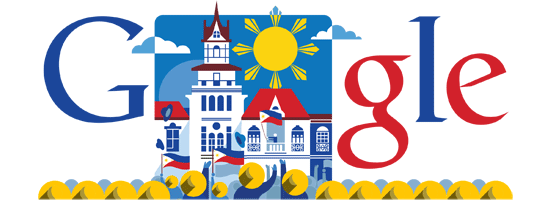 |
| Google Doodle Image Screenshot- at Google page (June 12, 2013 Independence Day) |
The Google Doodle is on the search engine's front page this Wednesday, June 12, shows an animated version of the scene from June 12, 1898, when the Declaration of Philippine Independence was made in Kawit, Cavite.
When you are on your search tasks, or if you visit Google's homepage (www.google.com or www.google.com.ph) you will be see animated doodle depicting the raising of the Philippine flag with the image of the ancestral home of Gen Emilio Aguinaldo in Kawit Cavite.
Last January this year 2013, I visited
The Philippines National Shrine, the Aguinaldo Shrine is the ancestral house of General Emilio Aguinaldo, the president of the 1st Philippine Republic. This became the place where the proclamation of the Republic of the Philippines was made, where the independence of the Philippines from Spain was declared on June 12, 1898.
The animated doodle bearing the colors of the Philippine flag. The letters in the word "Google" were in red, blue and yellow, with the sun with eight rays replacing the second "o."
 |
Google Doodle for Philippine Independence Day, 2013. (Image courtesy of Google)
Thanks Google for this Doodle!
You may check this out:
|
And more fun and informative I read this today thru facebook:)
Thanks also to
Read and Enjoy.
GOOGLE GREETS USERS WITH PHILIPPINE INDEPENDENCE DAY DOODLE
One of the most significant dates in the Philippine’s history is Independence Day because it marks the nation’s independence from the Spanish rule on June 12, 1898. Filipinos celebrate it annually on June 12.
What do People do?
Independence Day is a day when many people, including government officials, employees, and students, participate in nationwide parades. However, the main highlight is the police and military parade in Manila headed by the country’s incumbent president, followed by a speech and a 21-gun salute. Many Filipinos spend the day in parks and malls. Many Filipino communities in other countries also observe the nation’s Independence Day celebrations.
Public life
The Philippine’s Independence Day is a national holiday so government offices are closed. There are absolutely no classes in all schools. Many business establishments are closed except shopping centers. Public transport such as buses, passenger jeeps, and tricycles still operate but their routes may be limited due to the closure of streets used for parades.
Background
The annual June 12 observance of Philippine’s Independence Day came into effect after past President Diosdado Macapagal signed the Republic Act No. 4166 regarding this matter on August 4, 1964. This Act legalized the holiday, which is based on the Declaration of Independence on June 12, 1898 by General Emilio Aguinaldo and Filipino revolutionary forces from the Spanish colonization. The Philippines’ flag was raised and its national anthem was played for the first time in 1898. However, liberty was short-lived because Spain and the United States did not recognize the declaration.
The 1898 Treaty of Paris ended the war between Spain and the United States. Spain surrendered the entire archipelago comprising the Philippines to the United States. The Philippines started a revolt against the United States in 1899 and achieved national sovereignty on July 4, 1946, through the Treaty of Manila. Independence Day was officially observed on July 4 until the Republic Act No. 4166, which set out to move the holiday to June 12, was approved on August 4, 1964.
Symbols
The Flag of the Republic of the Philippines, representing the country is symbolized by the following:
1. Royal blue field – peace, truth, and justice.
2. Scarlet red field – patriotism and valor.
3. White triangle – equality and brotherhood.
4. Three stars on the corners of the triangle – the three main geographical regions of the country namely Luzon, the Visayas, and Mindanao.
5. The sun at the center of the triangle – has eight rays representing the eight Philippine provinces that started the revolt against Spain.
The flag is seen in various places across towns and cities in the Philippines during the country’s Independence Day. Many cars also sport miniature flags on this day.















































